
- The Savvy Promise
At Savvy, our mission is to empower you to make informed financial choices. While we maintain stringent editorial standards, this article may include mentions of products offered by our partners. Here’s how we generate income.
In this article
As part of Savvy’s research into road safety, we look at international road tolls (road fatalities) and compare them among English-speaking nations in the OECD.
- USA road fatalities of 11.78 per 100,000 population – highest of English-speaking countries
- New Zealand is second highest, with a rate of 6.01 deaths per 100,000 people
- Canada is third behind the USA and NZ with 4.59 road fatalities per 100,000 population
- Australia is fourth highest in terms of road fatalities with a rate of 4.26
- Ireland's road fatality rate per 100,000 is 2.96
- U.K. has lowest fatalities per 100,000 population, of 2.26 among English-speaking OECD countries
One of the most troubling aspects of modern industrialised society is the trade-off between ease of transportation and its dangers. Unfortunately, people lose their lives to road and traffic accidents all over the world. In Australia, we have made great strides to reduce the road toll (or road deaths/road fatalities) through more stringent safety standards, tougher penalties for ignoring safety laws (e.g., making seat belt use mandatory, harsher punishments for driving under the influence of alcohol), and education campaigns by state and territory road safety authorities.
Road safety is a significant challenge for nations in the Organisation of Economic Cooperation and Development (OECD.) As highly industrialised, wealthier nations, these countries have higher rates of car or vehicle ownership than non-OECD countries.
Among the anglophone (English-speaking) countries, there are many disparities in terms of road fatality statistics. Some of the most developed countries such as the United States are the most dangerous when it comes to road fatalities – while the United Kingdom is consistently among the safest. Australia itself is towards the middle of the pack, while New Zealand, by way of comparison, is far less safe.
Here, we’ll delve into the statistics about road fatalities and compare them among leading English-speaking nations.
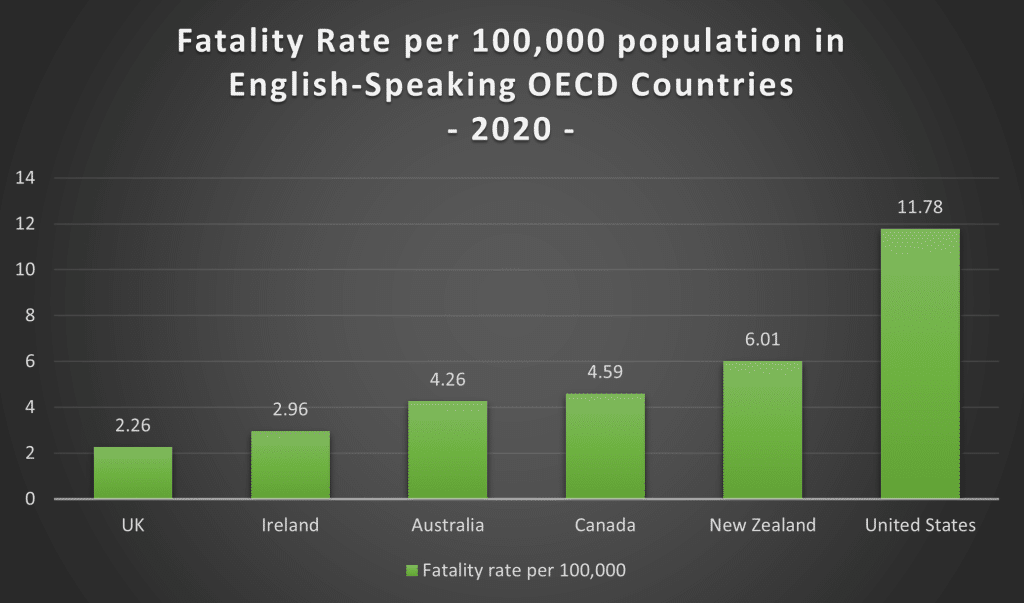
United States road fatality statistics – the benchmark
Road fatalities are a significant concern in the United States, as it consistently ranks among the most dangerous. According to the US Department of Transportation’s National Highway Traffic Safety Authority, 38,824 road fatalities were recorded during 2020, the highest year on record since 2007.
US fatality rates per capita and registered vehicle
The fatality rate per 100,000 population is an important indicator of road safety. In 2020, the United States had a fatality rate of 11.78 deaths per 100,000 population. Comparatively, New Zealand had the second-highest fatality rate among the countries analysed, with 6.01 deaths/100,000 population, while the U.K. had the lowest rate at 2.26 deaths per 100,000 population, while the OECD median fatality rate was 4.09.
Examining the changes in fatality rates over time can reveal trends in road safety. From 1990 to 2020, the fatality rate in the United States decreased from 17.9 to 11.78 deaths per 100,000 population. This downward trend indicates improvements in road safety measures. However, it is important to note that there was a slight increase in the fatality rate from 2017 to 2020. The lowest point was in 2014, when the rate dropped to 10.3, after which the fatality rate trended upward to 2020.
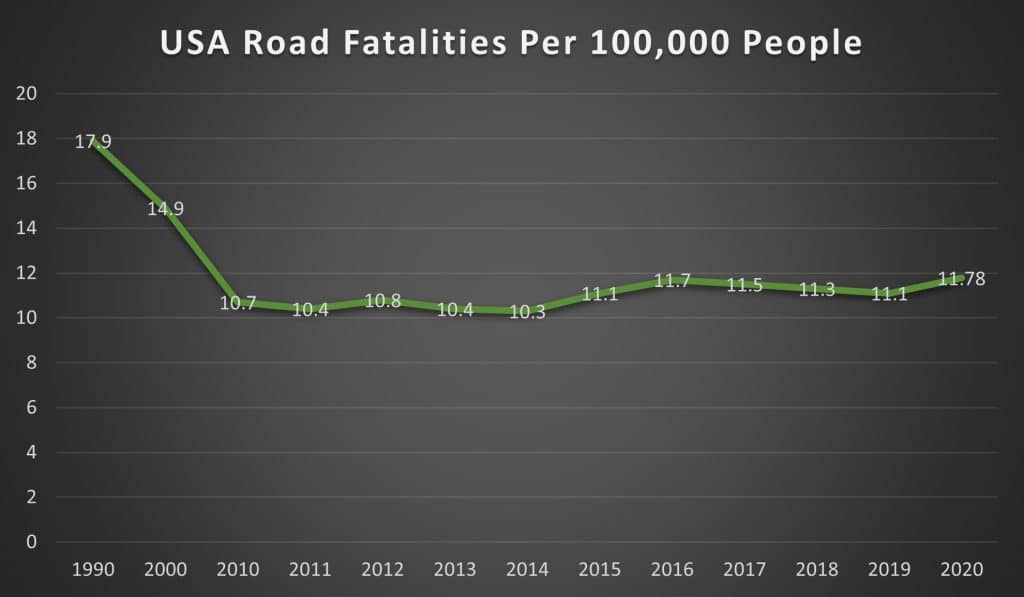
BITRE.gov.au – (Pg.4)
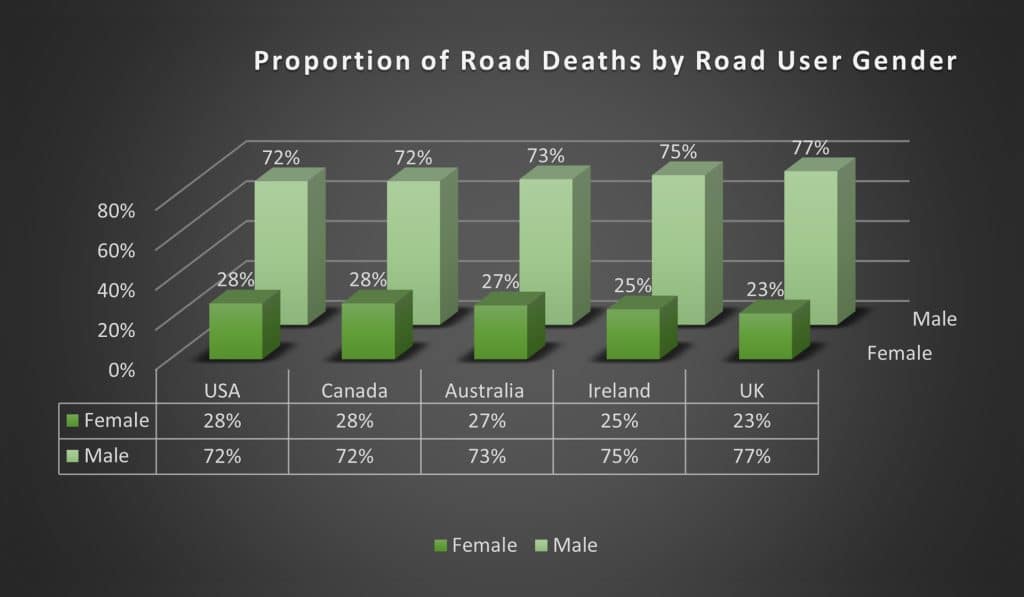
BITRE.gov.au – (Pg.22)
Examining the changes in fatality rates over time can reveal trends in road safety. From 1990 to 2020, the fatality rate in the United States decreased from 17.9 to 11.78 deaths per 100,000 population. This downward trend indicates improvements in road safety measures. However, it is important to note that there was a slight increase in the fatality rate from 2017 to 2020. The lowest point was in 2014, when the rate dropped to 10.3, after which the fatality rate trended upward to 2020.
In 2020, the United States had a fatality rate of 1.30 deaths per 10,000 registered vehicles. Compared to other countries, the United States had a relatively higher fatality rate in this category. The closest English-speaking country was New Zealand, at 0.69 deaths per 10,000 registered vehicles. The OECD median is 0.52.
Annual Fatality Rate Per 100,000 Population by Jurisdiction
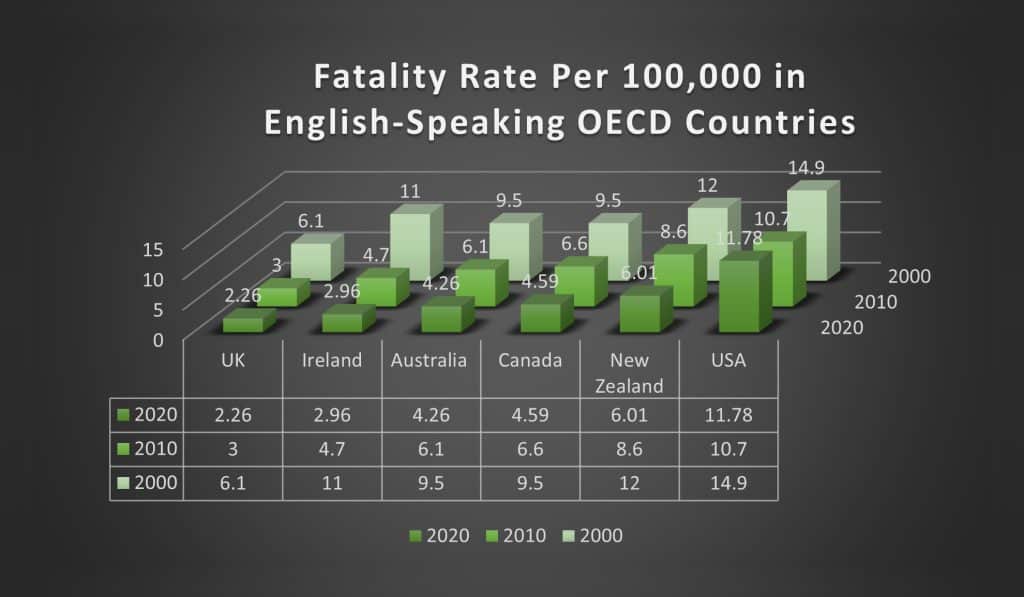
BITRE.gov.au – (Pg.4)
| Nation | Road | Population | Fatality rate per 100,000 |
| deaths | (000s) | population | |
| Norway | 93 | 5,368 | 1.73 |
| Sweden | 204 | 10,328 | 1.98 |
| Iceland | 8 | 364 | 2.20 |
| United Kingdom | 1,516 | 67,082 | 2.26 |
| Switzerland | 227 | 8,606 | 2.64 |
| Japan | 3,416 | 125,708 | 2.72 |
| Denmark | 163 | 5,823 | 2.80 |
| Spain | 1,370 | 47,333 | 2.89 |
| Ireland | 147 | 4,964 | 2.96 |
| Germany | 2,719 | 83,167 | 3.27 |
| Israel | 305 | 9,215 | 3.31 |
| Netherlands | 610 | 17,408 | 3.50 |
| Slovenia | 80 | 2,096 | 3.82 |
| Austria | 344 | 8,901 | 3.86 |
| France | 2,541 | 65,124 | 3.90 |
| Portugal | 404 | 10,296 | 3.92 |
| Italy | 2,395 | 59,641 | 4.02 |
| Finland | 223 | 5,525 | 4.04 |
| OECD median | 4.09 | ||
| Luxembourg | 26 | 626 | 4.15 |
| Australia | 1,094 | 25,655 | 4.26 |
| Belgium | 499 | 11,522 | 4.33 |
| Estonia | 60 | 1,329 | 4.51 |
| Slovak Republic | 247 | 5,459 | 4.52 |
| Canada | 1,746 | 38,025 | 4.59 |
| Hungary | 462 | 9,770 | 4.73 |
| Czech Republic | 517 | 10,694 | 4.83 |
| Greece | 584 | 10,719 | 5.45 |
| Turkey | 4,866 | 83,385 | 5.84 |
| Korea | 3,081 | 51,781 | 5.95 |
| New Zealand | 306 | 5,094 | 6.01 |
| Lithuania | 175 | 2,795 | 6.26 |
| Poland | 2,491 | 37,958 | 6.56 |
| Latvia | 141 | 1,900 | 7.42 |
| Chile | 1,794 | 19,458 | 9.22 |
| Colombia | 5,447 | 50,372 | 10.81 |
| United States | 38,824 | 329,484 | 11.78 |
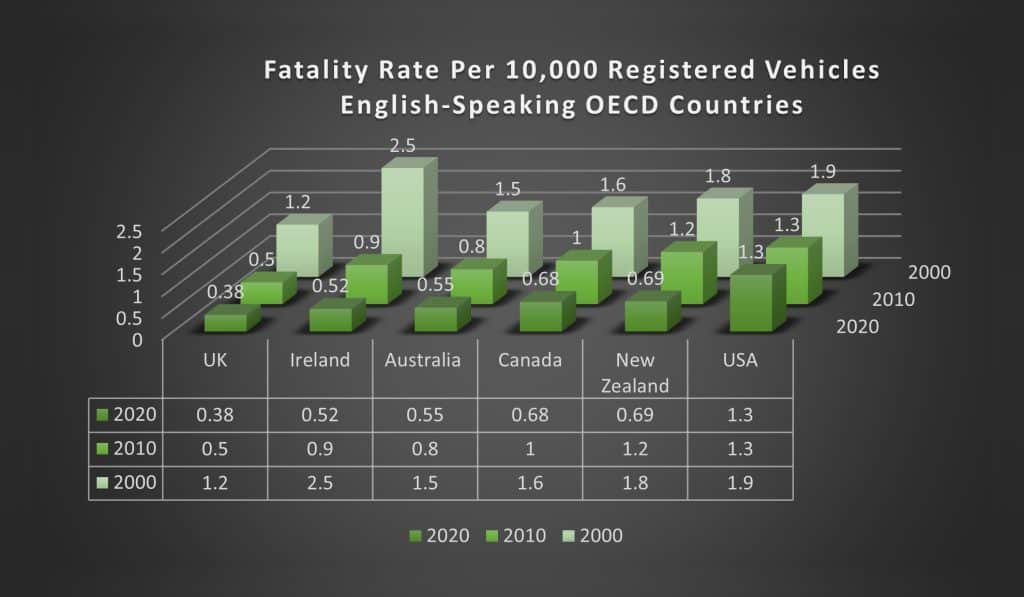
BITRE.gov.au – (Pg.8)
Fatality Rate Per 100,000 Population – English-Speaking OECD Countries
| Country | 1990 | 2000 | 2010 | 2020 | United Kingdom | 9.4 | 6.1 | 3.0 | 2.26 |
|---|---|---|---|---|
| Ireland | 13.6 | 11 | 4.7 | 2.96 |
| Australia | 13.7 | 9.5 | 6.1 | 4.26 |
| Canada | 14.3 | 9.5 | 6.6 | 4.59 |
| New Zealand | 21.4 | 12 | 8.6 | 6.01 |
| United States | 17.9 | 14.9 | 10.7 | 11.78 |
BITRE.gov.au – (Pg.4)
Fatality Rate per 10,000 Registered Vehicles – English-Speaking OECD Countries
| Country | 1990 | 2000 | 2010 | 2020 | United Kingdom | 2.1 | 1.2 | 0.5 | 0.38 |
|---|---|---|---|---|
| Ireland | 4.5 | 2.5 | 0.9 | 0.52 |
| Australia | 2.3 | 1.5 | 0.8 | 0.55 |
| Canada | 2.3 | 1.6 | 1.0 | 0.68 |
| New Zealand | 3.3 | 1.8 | 1.2 | 0.69 |
| United States | 2.4 | 1.9 | 1.3 | 1.3 |
BITRE.gov.au – (Pg.8)
Breakdown by age group, road user group, and gender
In 2020, the United States had a proportion of road deaths by age group as follows: 3% in the 0-14 age group, 17% in the 15-24 age group, 63% in the 25-64 age group, and 17% in the 65+ age group. Compared to other English-speaking OECD countries, the United States (17%) had a higher proportion of road deaths in the 15-24 age group, similar to Canada (17%) and Australia (17%), but lower than Ireland (10%) and the United Kingdom (16%). Older drivers 65 and older involved in fatal crashes decreased by 9.8% compared with 2019. The 25-34 age bracket saw the highest increase of fatalities (1,117.)
Looking at the road user group statistics, the United States had 35% of road deaths categorised as passenger car occupants, 17% as pedestrians, 14% as motorcyclists, 2% as cyclists, and 31% as other. Comparing these figures to other OECD English-speaking countries, the United States had a lower proportion of road deaths among cyclists compared to Canada (3%), Australia (4%), and the United Kingdom (10%), but a higher proportion of road deaths in the “other” category.
Key findings from the NHTSA showed that Urban fatalities increased by 8.5% and rural fatalities increased by 2.3%. 42 out of the 50 states including the District of Columbia saw increases in the number of road deaths. Nighttime (6 p.m. to 5:59 a.m.) fatalities increased by 12%; daytime (6 a.m. to 5:59 p.m.) traffic fatalities increased by 1.4%.
When considering gender, the United States had 72% of road deaths among males and 28% among females. This distribution was similar to Canada and Australia, but different from the United Kingdom, where males accounted for 77% of road deaths. Male deaths increased by 8.6% and female fatalities increased by 1.9%.
The United States exhibited certain similarities and differences in road fatality statistics compared to other OECD English-speaking countries, highlighting the importance of analysing these figures to identify areas for targeted road safety measures.
 Australia
Australia
New Zealand road fatality statistics
With 6.01 deaths recorded for every 100,000 people in the population, New Zealand is one of the least safe nations when it comes to the risk of being killed on the road. This puts them in seventh worst position among the OECD countries with the highest rate of fatalities. Their incidence of fatalities was 0.69 for every 10,000 automobiles registered in their state. New Zealand’s trend line for fatalities per 100K population has been downward, halving each decade: 21.4 in 1990, 12 in 2000, and 8.6 in 2010.
In terms of the types of people who were killed while using the road, around 66% were either passengers or drivers, 10% were pedestrians, 18% were motorcyclists, and 4% were cyclists. The mortality rate in New Zealand was 0.66 cases for every 100 million vehicle kilometres travelled (VKT).
United Kingdom road fatality statistics
The UK is the fourth safest OECD country in terms of road fatalities per 100,000 head of population with 2.26, just behind the top three of Iceland, Sweden, and Norway. As mentioned above; they rank first when compared to other English-speaking countries. Their fatality rate per 10,000 registered vehicles was slightly higher at 0.38, behind Japan and Spain (0.37) and Switzerland (0.35.) However, they have managed to halve this number over the past two decades – their fatality rate was 1.2 in 2000 and 0.5 in 2010.
43% of road fatalities were suffered by passenger or car occupants, 23% by pedestrians, 20% by motorcyclists, 10% by cyclists, and 5% by “other.” 77% were male and 23% were female. 2% were aged 0-14, 16% 15-24, 58% 25-64, and 24% over the age of 65.
The fatality rate in the United Kingdom per 100 million VKT was 0.34.
Ireland road fatality statistics
Ireland is towards the top of the league tables in terms of road fatality safety for English-speaking OECD countries. Their fatality rate per 100,000 population is 2.96. Ireland’s fatality rate has trended downward since 2000, where their road fatality rate per 100,000 was 11, more than halving in a decade at 4.7 in 2010. It would seem they achieved another halving of the fatality rate in the ensuing decade. In another measure, Ireland’s fatality rate per 10,000 registered vehicles is 0.52.
The fatality rate per 100 million VKT was 0.41, the OECD median.
In terms of age-group, in 2020 Ireland had 5% of deaths in the 0-14 age group, 10% in 15-24, 63% in 25-64 and 22% in 65+.
Canada road fatality statistics
Canada is towards the middle of the pack when it comes to road safety, with a 4.59 road fatalities per 100,000 population. Canada’s road fatality statistics have trended downward in the previous decades, recording a rate of 9.5 in 2000 and 6.6 in 2010. Their fatality rate per 10,000 registered vehicles was 0.68.
58% of Canadian road fatalities were among car drivers or passengers, followed by 16% of pedestrians, 14% of motorcyclists, and 3% of cyclists. Canada’s fatality rate per 100 million vehicle kilometres travelled (VKT) was 0.47. 3% of deaths were recorded among 0-14s, 17% among 15-24s, 59% among 25-64s, and 22% over the age of 65.
 Australia
Australia
A quick look at Australia
In terms of Australia’s road fatality rate per 100,000 population, Australia’s rate was 4.26, ranking 20th out of the 36 OECD nations. This declined from a rate of 6.1 in 2010, trending downward over the next decade. Australia sits ahead of several other English-speaking countries, which are Canada, New Zealand and the United States.
The fatality rate per 10,000 registered vehicles was 0.55, ranking 18th among 30 nations with available data. This dropped consistently over the preceding ten-year period, from 0.8.
As for the fatality rate per 100 million vehicle kilometres travelled (VKT) in 2020, Australia’s rate was 0.44 –9th out of 15 nations with available data. In Australia during 2020, vulnerable road users (motorcyclists, pedestrian, or cyclists) accounted for 35% of total road deaths, which is lower than the OECD average of 44%.
Australia’s distribution of deaths by age group shows 4% between 0-14s, 19% between 15-24s, 59% between 25-64s, and 19% for over 65s. The gender breakdown was 73% male and 27% female. In terms of deaths by road user group in Australia, 48% were passenger car occupant, 12% were pedestrians, 17% motorcyclists, 4% cyclists and 19% were classified as “other”.

BITRE.gov.au – (Pg.18)
Proportion of Road Deaths by Road User Group – 2020
| Country | Passenger | Pedestrian | Motorcyclist | Bicycle | Other | United Kingdom | 43% | 23% | 20% | 10% | 5% |
|---|---|---|---|---|---|
| Ireland | 48% | 22% | 12% | 7% | 12% |
| Australia | 48% | 12% | 17% | 4% | 19% |
| Canada | 58% | 16% | 14% | 3% | 9% |
| New Zealand | 66% | 10% | 18% | 4% | 2% |
| United States | 35% | 17% | 14% | 2% | 31% |
BITRE.gov.au – (Pg.20)
Can we get to Zero road toll?
It would seem that many OECD countries have their own challenges to bringing their road tolls or road fatality statistics down. Most trends in the OECD have shown a decrease in road fatalities in the last decade or two. Even in the “unsafest” countries such as the United States and New Zealand, great strides have been taken to reduce the road fatality rate. New Zealand’s rate per 100,000 has roughly halved each decade.
Though cars may be safer and education campaigns may be more prevalent, it may take a quantum leap in technology – accessible for all countries – to whittle the road toll down to even lower levels, or that long-strived for zero number.
Did you find this page helpful?
Author
Adrian EdlingtonPublished on July 21st, 2023
Last updated on March 14th, 2024
Fact checked
This guide provides general information and does not consider your individual needs, finances or objectives. We do not make any recommendation or suggestion about which product is best for you based on your specific situation and we do not compare all companies in the market, or all products offered by all companies. It’s always important to consider whether professional financial, legal or taxation advice is appropriate for you before choosing or purchasing a financial product.
The content on our website is produced by experts in the field of finance and reviewed as part of our editorial guidelines. We endeavour to keep all information across our site updated with accurate information.










